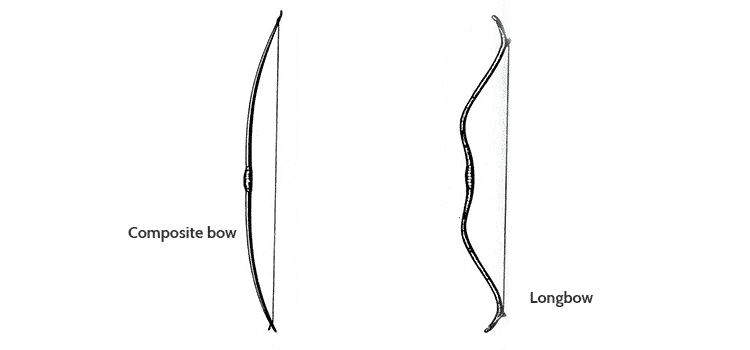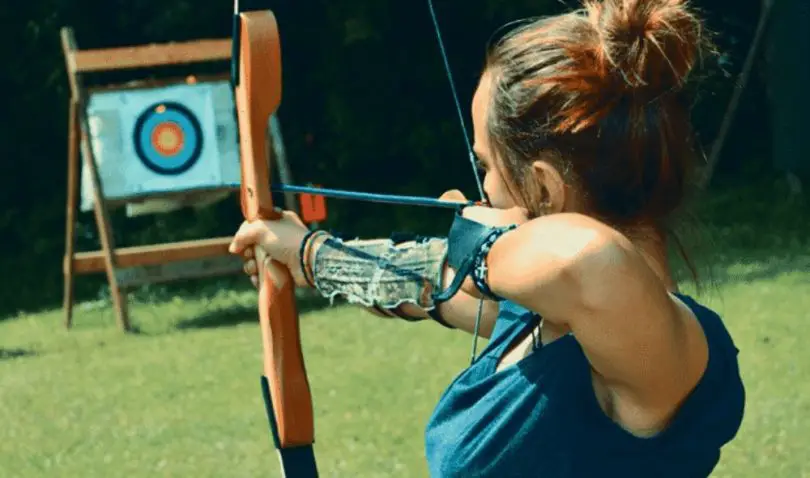Do you know that using the wrong type of bow regarding your physical characteristics, height, age, strength, and proficiency level can make even an upper-intermediate user shoot like they don’t know how to aim?
Yes, it is true. I’ve seen lots of people struggling with their bows and improving their skills in only several days of practice after picking a different type of bow. Choosing the most suitable longbow and composite bow makes a huge difference.
Longbows are sometimes seen as traditional, oversized, and heavy bows, while composite bows are sometimes underrated regarding their power.
We are here to bust the myths and provide truthful information on composite bows and longbows. Also, we will talk about their design and how it affects performance.
Most noteworthy, we will help you to pick the perfect bow for yourself. Dive into our in-depth “composite bow vs longbow” comparison to pick the best option for your specific needs.
Composite Bow Vs Longbow: Key Differences

Composite bows and longbows have lots of similarities, but also many differences that dictate the use, maintenance, and repair, as well as the pros and cons of these two bow types. Today, we’re deciding the winner of the composite bow vs longbow based on:
- Design
- Material
- Uses
- Benefits
- Draw length
- Limitations
- Maintenance and care guidelines
Let’s explore the difference between an English longbow and a composite bow in more detail.
1. Design
The key differentiating factor of this “English longbow vs Composite bow” comparison is the design. Each of these two bow types has its own design features that make them stand out, both aesthetically and from the aspect of performance.
Let’s see what the composite and longbow design peculiarities are.
| Composite bow | Longbow |
| The design of composite bows is perhaps the most interesting design of the mall. Why is that so? Simply put, composite bows are made from two or more materials, which implies that they are made from pieces as well.
If we observe the traditional design of these bows, they have a triple-layer structure. Those three layers include wood, horn, and sinew. However, today, we use other different materials. When it came to the shape, these bows resemble recurve bows, i.e. their shape is recurved. |
A longbow is usually made from wood. They are usually made from one piece. This is the key difference between this type and the composite type.
Moreover, one of the most prominent design features of longbows is the D-shaped limb-string forms. They resemble a crescent. There are no additional curves on the limbs. Also, the first thing you notice about the longbow design is its extraordinary length. Actually, longbows are the longest bows ever made! |
2. Material
Materials play a very important role in the quality and performance of bows, especially when it comes to composite bows.
| Composite bow | Longbow |
| While getting a strong composite bow, its material comes on top. The name itself – composite bow, implies that this bow type is made from two or more different materials. The traditional version of composite bows is made from a wooden core and horn and sinew on the outside.
Today, different producers choose different materials, but the principle is the same. There must be three materials. Usually, we see various types of wood glued together or combined with fiberglass, or even a very interesting material called carbon fiber. When it comes to the choice of wood, composite bow core is usually made from red elm or maple. Other popular wood types include cedar and bamboo. |
As we have already mentioned in the previous section, longbows are usually made from wood.
Today, laminated wood is most commonly used for this type of bow. In addition, carbon-centered bows are popular lately. Another material often used for longbows is layered fiberglass. These modern materials provide better technical features for this type of bow. However, you can still find some amazing examples of good old wooden longbows. |
3. Uses and benefits
Here we come to the most interesting part for the users – the uses and benefits of composite bows and longbows. We highly recommend you read the following sections with attention, as knowing more about the uses and advantages of each type will help you identify your perfect bow.
| Composite bow | Longbow |
| The key advantage of using a composite bow is its compact size. It is significantly smaller than an average longbow model. Similarly, composite bows are lighter than longbows.
Most noteworthy, these bows are powerful, strong, and flexible. These benefits result from the unique design of composite bows. Namely, each small piece of material used to construct the bow acts as a separate unit. In this way, the bow gets extra strength, while keeping its flexibility at a high level. As a result, you should use a composite bow in situations where either you or the target is on the move. |
If you are looking for a bow with a straight-line arrow path, here it is – the longbow. Its design is responsible for such an interesting and convenient benefit.
You can make satisfactory results with this type of bow, even at the beginning of your career/hobby activities, which is not easy with a short bow. This bow is also good for hunting, despite its large dimensions, due to the fact that it does not make much noise. This is the result of minimal contact between the limbs and the string. Last but not least, longbows are elegant, vintage, and perfect for those who are amazed by the historic bow types. |
4. Draw length
In this section, we want to share some important information on determining the draw length of your composite bow and longbow as per the dynamics of the bow and arrow.
Pay attention to the information, as the correct draw length will heavily affect your performance.
| Composite bow | Longbow |
| To calculate the perfect draw length of your composite bow, follow these simple steps.
First, measure the distance between the nock point and the pivot point on the grip. Pay attention to the following: the measurement line must be perpendicular to the bow center line. Then, add 1.75 inches to the result. This is your perfect composite bow draw length. |
We recommend you use a slightly different method if you want to determine the draw length of a longbow.
First, precisely measure the value of the distance between the nock point and the throat grip. After that, simply add 1 ¾ of an inch to the previously obtained result. This is your longbow draw length. |
5. Limitations
Except for their amazing features and benefits, both composite and longbows have certain limitations.
Those limitations are the consequences of their specific design features and material types. Let’s see what those limitations are in detail.
| Composite bow | Longbow |
| One of the greatest flaws of composite bows is limb twist sensitivity. Namely, these bows are sensitive to twists due to certain design features that ensure better performance.
How can this problem be solved? The knees and ears of the bow should be reduced during the factory production process. How much should they be reduced? To the minimum loadbearing capacity! What are the consequences of this approach? The result is a somewhat reduced composite bow performance. In addition, experts say that moisture is another enemy of composite bows. Even though it will not heavily damage your bow nor significantly affect your performance, it will drop the draw weight. |
The greatest drawback or limitation of the longbow type is poor portability.
As we have mentioned multiple times throughout the article, longbows are very long, as their name itself implies. It is not very easy to maneuver this type of bow, especially in the woods. Furthermore, arrows will go a bit more slowly than those of the composite bow type. When it comes to repairs, we can say that this is another significant limitation. Stay with us and learn more in the following section. |
6. Care and maintenance requirements
Care and maintenance are very important factors when you are choosing your bow type. If you are not a professional, you will probably not be able to buy a new bow every once in a while.
In addition, your access to repair services might be limited. This is why you should think of the ease of repairs and maintenance requirements prior to your purchase.
| Composite bow | Longbow |
| Pay special attention to the twisting tendency of your composite bow within the first three months of use. This is the period within which you can correct any deformations.
Moreover, try to use your bow as much as you can. This will actually improve the performance of the bow, alongside yours, of course! When it comes to maintenance and care requirements, try to protect your bow from the simultaneous effects of heat and moisture. Keep it in a shady place. When it comes to ease of repairs, we must say that composite bows are easily fixed as they consist of several parts that are usually hand-made. |
As we have already mentioned in the limitations section, the longbow type is not the very best pick when it comes to maintenance and repair.
Whether you make a longbow or get one from the market, the maintenance job is going to be hard. When it comes to caring requirements, you should pay attention to moisture and exposure to direct sunlight, as this may damage the wood. |
Is a Composite Bow Better Than a Long Bow?
Let’s address the elephant in the room. The answer to this question really depends on the user’s individual preferences and needs.
The composite bow is a newer technology that has some distinct advantages over the traditional longbow.
Generally speaking, a composite bow will have more power behind it, allowing it to shoot arrows faster and farther whereas a composite bow can be made with different draw weights, giving the user more control over shot power and accuracy.
The draw weight can also be adjusted on composite bows, allowing users to customize their bow to their own strength level and preferences.
The primary drawback of a composite bow is its cost. Generally speaking, a good-quality composite bow will be much more expensive than a longbow.
Overall, the decision for the composite bow vs longbow debate really comes down to individual needs and preferences.
If you’re looking for power, accuracy, and adjustability, then a composite bow is likely your best option. However, if cost is an issue or if you prefer traditional archery techniques, then a longbow may be the best option for you.
Conclusion
Composite bows are the best choice for expert archers who will use their bows in motion. If you are keen on traditional styles, i.e. you want to use your bow while riding a horse, look no more. A composite bow is supposed to be your top choice.
If you are a beginner or you prefer the English or Welsh bow style, and you are looking for a straight-line arrow path, we suggest you get a longbow. Also, if you want to buy a silent-operation bow, pick this type.








Leave a Comment